Samsung Fascinate Review: Verizon's Galaxy S Smartphone
by Brian Klug on October 5, 2010 12:01 AM EST- Posted in
- Smartphones
- Samsung
- Galaxy S
- Fascinate
- Mobile
Hardware Impressions and Analysis
The Fascinate feels unlike almost any other high-end Android device I've had the chance to review so far. Where other smartphones are predominantly metal and thus pack some considerable heft, the Fascinate is lightweight and just a tad plasticky. It's simultaneously amazing that a smartphone can feel so insubstantial, and just a bit unnerving.
The second thing that's striking about the Fascinate is that it's also incredibly thin. In fact, it's nearly as thin as the iPhone 4:

(Left to right) Motorola Droid 2, Samsung Fascinate, iPhone 4
By the numbers, the Fascinate is just 0.61 mm thicker than the iPhone 4. But it's also 10 grams lighter. You've got our usual comparison table to compare thicknesses on paper, but it's hard to really convey just how thin the Fascinate feels. The rest of the Galaxy S line - with the exception of the Epic - shares this same impressive waistline.
To that extent, whether you like or hate how the phone feels in your hand will depend on whether you gauge quality as a function of mass. If heavier and more substantial translates to better constructed for you, the Fascinate will undoubtedly feel a bit cheap. However, if you're all for lighter and thinner devices, the Fascinate is perfect - it's the kind of device you can forget is in your pocket despite having a 4 inch screen.
I mentioned that the phone feels somewhat plasticky to me - it's entirely because of the build material you're in contact with. The back cover itself is entirely smooth, glossy plastic. Likewise, the sides and edges of the Fascinate are glossy plastic. The unfortunate consequence of this choice is that - like the iPhone, it's prone to scratching almost immediately and showing fingerprints. Even living completely alone in my pocket for a week or two, the Fascinate's back is now visibly scratched under the right angle of illumination. I promise it isn't as noticeable as it looks here, but it's enough to occasionally shock when the light catches it the wrong way. It's eerily reminiscent of how prone to scratching the iPhone 3G and 3GS backs are.
There's a dark glossy checkerboard pattern on the back, but the actual surface itself is completely smooth. The Fascinate's back cover material is thus very similar in nature to the Vibrant.
Getting the cover off involves sticking your thumb in a small notch the bottom of the device and literally prying the whole thing off. There's a small raised bit for the speakerphone output on the rear of the device, and two notches for getting that audio out.
The camera and flash area protrudes through the back cover and doesn't come off. This is nice, as on devices like the Nexus One, there's a second plastic layer between the camera integrated into the back cover where fingerprints and gunk collect, adding to camera glare.
Under the cover, the Fascinate is pretty spartan. There's the click-to-eject type microSD port, and down below is a 5.55 Whr Li-ion battery.
On the left are the volume rocker button and a port for the secondary microphone for noise cancellation. You can follow that port inside to a small chamber where the microphone is. There aren't any markers on the volume rocker - then again up and down are pretty obvious. The volume rocker is also a multipurpose zoom control in the browser and camera application, which is probably part of why it's left unmarked.
The right side is pretty boring, sporting the power button (which is thankfully marked) about 2/3rds up the side of the device. Location of the power button is perfect for your thumb when held in the right hand, or index finger when held in the left hand.
Things are interesting up top. There's the standard 1/8", 3.5 mm audio jack for headphones, a "Digital by Qualcomm" sticker, and the microUSB cover hiding the port underneath. The cover itself slides back and forth and has two detents that hold the cover open or closed. There's a groove you can get your nail into to slide the mechanism.
Putting the microUSB port on the top may seem like a strange choice - something I even pointed out in the Nokia N900 review - but it makes some sense. For one, it gets the cable out of the way when you're using the device while charging. Second, it also means you can dump the phone right side up into a cupholder in the car while on the go. For me at least, having the charger somewhere other than the side makes using the device while charging or taking screenshots a heck of a lot less of a balancing act.
It's a choice that will probably seem very strange to people at first, but definitely doesn't impede using the Fascinate plugged in.
The Fascinate's hardware for me is ultimately a mixed bag. I love the fact that it's thin and light, but it feels so insubstantial in my hands that sometimes I forget it's a tier-1 smartphone. That isn't to say that the Fascinate feels cheap or has bad build quality - it doesn't - it just doesn't really inspire gobs of confidence the first time you pick it up. There's no rattling when the Fascinate vibrates, something I find indicative of build quality, and there's no doubt about the rigidity of the structure. It just has a weird feel in an open palm.
I really like that the Fascinate is thin and lightweight - I just don't like that the back feels the way it does.
The most obvious physical comparisons to the Fascinate's 4" form factor are the Droid X and the EVO 4G. I don't have the Droid X anymore and thus couldn't grab a shot, but I do have Anand's EVO 4G. The two are almost the same size wise, with the Droid X being just a few millimeters taller. I tossed in the iPhone 4 for good measure:
125 mm (4.92")
| Physical Comparison | |||||||||
| Apple iPhone 4 | HTC EVO 4G | Motorola Droid X | Motorola Droid 2 | Samsung Galaxy S Fascinate | |||||
| Height | 115.2 mm (4.5") | 121.9 mm (4.8") | 127.5 mm (5.02") | 116.3 mm (4.6") | 125 mm (4.92") | ||||
| Width | 58.6 mm (2.31") | 66.0 mm (2.6") | 66.5 mm (2.62") | 60.5 mm (2.4") | 63.5 mm (2.5") | ||||
| Depth | 9.3 mm ( 0.37") | 12.7 mm (0.5") | 9.9 mm (0.39") | 13.7 mm (0.54") | 9.91 mm (0.39") | ||||
| Weight | 137 g (4.8 oz) | 170 g (6.0 oz) | 155 g (5.47 oz) | 169 g (5.9 oz) | 117 grams (4.16 oz) | ||||
| CPU | Apple A4 @ ~800MHz | Qualcomm Scorpion @ 1GHz | TI OMAP 3630 @ 1GHz | Texas Instruments OMAP 3630 @ 1 GHz | 1 GHz Samsung Hummingbird | ||||
| GPU | PowerVR SGX 535 | Adreno 200 | PowerVR SGX 530 | PowerVR SGX 530 | PowerVR SGX 540 | ||||
| RAM | 512MB LPDDR1 (?) | 512MB LPDDR1 | 512MB LPDDR1 | 512 MB LPDDR1 | 512 MB LPDDR1 | ||||
| NAND | 16GB or 32GB integrated | 8GB micro SD | 8GB micro SD | 8 GB integrated, preinstalled 8 GB microSD | 2 GB, 16 GB microSD (Class 2) | ||||
| Camera | 5MP with LED Flash + Front Facing Camera | 8MP with dual LED Flash + Front Facing Camera | 8MP with dual LED Flash | 5 MP with dual LED flash and autofocus | 5 MP with auto focus and LED flash | ||||
| Screen | 3.5" 640 x 960 LED backlit LCD | 4.3" 480 x 800 | 4.3" 480 x 854 | 3.7" 854 x 480 | Super AMOLED 800 x 480 | ||||
| Battery | Integrated 5.254Whr | Removable 5.5Whr | Removable 5.698 Whr | Removable 5.2 Whr | Removable 5.55 Whr | ||||
Product packaging is an increasingly important aspect of smartphone presentation. Where the Motorola Droids thus far have been packaged in small and relatively basic boxes for optimal packing density, the Fascinate has more lavish, larger packaging. Inside the box you get phone on top, then below it are manuals, power adapter, and USB cables. Pretty standard fare, but still nicer than I've seen other packaging.


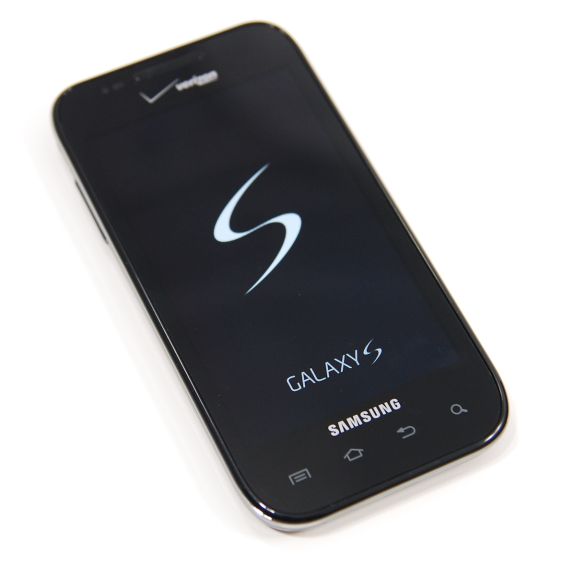
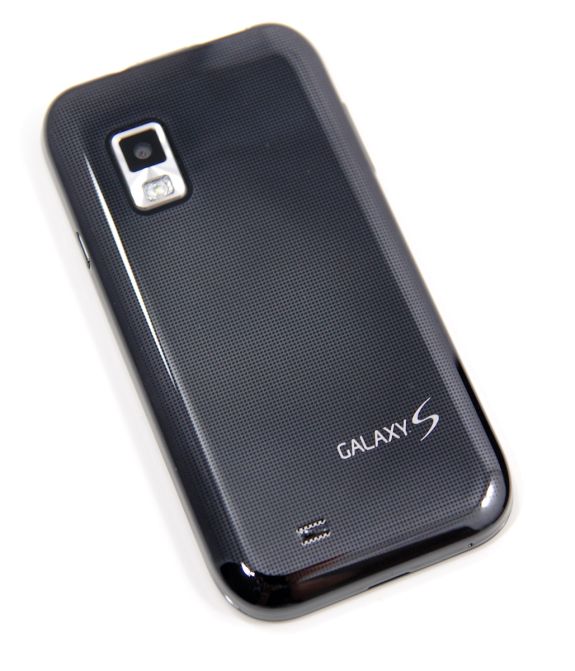
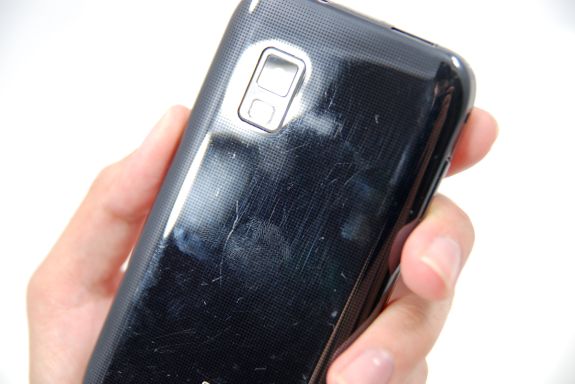

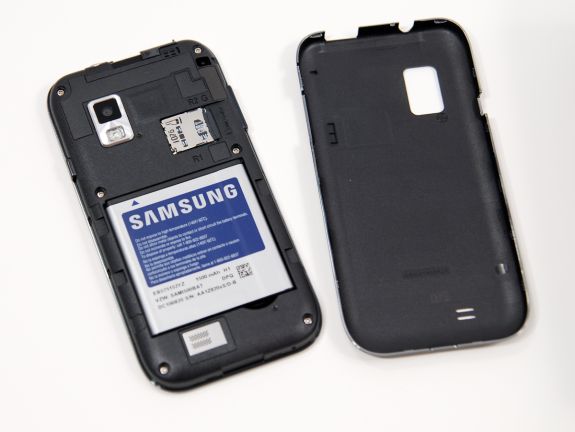




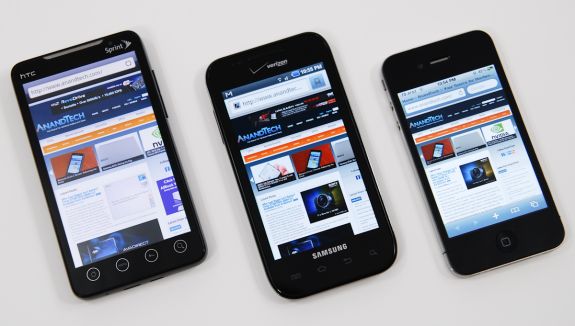
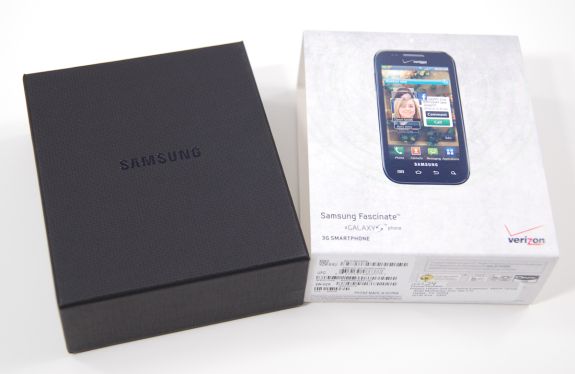








73 Comments
View All Comments
netmasterjohn - Tuesday, October 5, 2010 - link
How come Fascinate & Nexus One video are the same?dman - Tuesday, October 5, 2010 - link
I appreciate the testing methodology including the GPS fix times. I had an ATT Tilt (HTC 8925) which was notoriously slow in getting locked in. I got into the habit of starting the GPS app as soon as I'd get outdoors so that by the time I'd get to my vehicle it'd only have a couple minutes left. That and a few other workarounds. Sad that they still have issues these days...Chadder007 - Tuesday, October 5, 2010 - link
My Droid X came with a 16GB card, not 8.chemist1 - Tuesday, October 5, 2010 - link
Brian: Thanks for your reply. I'm pleased to hear you're trying to move in that direction. The idea of playing with CDMA voice codecs is intriguing -- I didn't occur to me that the audio quality (AQ) of smart phones could actually be user-modifiable at the software level. Though much of what determines AQ is hardware—the quality of the speaker in the earpiece, the circuitry upstream of it (and at the headphone jack output), the quality of the microphone (for those on the receiving end of your call), etc.More broadly, I like your general program of trying to put all areas that are now subjective onto a more objective footing. The problem with doing that for AQ is that it’s tricky. Often something can measure well, yet sound mediocre—which typically means that the measurements being used aren’t the right ones (for instance, maybe you’re measuring distortion, but the real problem is a phase error); or, alternately, perhaps the measurements aren’t being weighted properly. One solution is to supplement measurements with purely subjective, yet controlled, observations (a listening panel). You could also evaluate audio under compromised conditions by checking word recognition accuracy (but the danger here is that what might help accuracy under poor conditions—say, a boosted upper midrange—might make the phone fatiguingly harsh to listen to under normal conditions). Beyond that, I’d just reiterate what I said in my first post—I’d advise bringing in someone with a trained ear and/or lots of audio testing experience (if that's possible). [You can test for a trained ear by seeing if he/she can distinguish between different codecs in a single-blind test; or, alternately, perhaps you know, say, a recording engineer or a good classical pianist.]
Also, if you would, please ask Anand to read the Heijligers link I posted in my last comment, before he next tests iPods! [And you or he might wish to test the Redwine modification available for the 4G–5.5G iPods (http://redwineaudio.com/products/imod), to hear for yourselves what difference improved output circuitry can make in PMP AQ.]
Ranari - Tuesday, October 5, 2010 - link
*NOTE TO AUTHOR*Verizon and Microsoft have an advertising contract between each other, which is why you see Bing plastered all over the Samsung Fascinate. Businesses can control mobile ads in the Bing search engine using the Microsoft Adcenter. Mind you, this is over the Verizon network, but you can also see a few Bing mobile ads on m.bing.com, or if you download the Bing app on your smartphone. If you want a more Google experience, the other carriers will probably be your thing, but I find it to be more of an extension of the Android OS.
Personally, I think Bing has a pretty awesome mobile platform.
Aside from that, the review perfectly matches up with my thoughts about my Samsung Vibrant (T-Mobile).
-The Super AMOLED is absolutely gorgeous.
-The GPU is overkill, and I like it that way.
-Performance is great
-Battery life is mediocre
-And the GPS sucks bizalls
Cheers!
silverblue - Wednesday, October 6, 2010 - link
Sorry, didn't mean to be picky. :)anaxagoras1986 - Wednesday, October 6, 2010 - link
I'm not sure how the Galaxy is clearly better. It has a better GPU which is great, but only if you can use it. I don't play games so GPU performance is less important to me.Real-world performance with an Incredible (all of which are 2.2 now, why are you still testing or showing 2.1 results?) is close to the Nexus One 2.2 and HTC Evo 2,2. The charts show the 2.2 phones with a substantial performance advantage over the Galaxy.
So how is the Galaxy clearly better?
Doppleganger77 - Wednesday, October 6, 2010 - link
Even applying just the lag fix (fixes file system) to a 2.1 Galaxy S dramatically increases performance. For example, in the Quadrant benchmark I routinely achieve over 2200 points compared to about 800 for a standard Galaxy S. The Nexus One 2.2+ by comparison achieves around 1300 points. By applying a one click solution this phone can fly.ezinner - Thursday, October 7, 2010 - link
Arghh! I love the Galaxy S phones, but why oh why can't they put phone function buttons on the phone? Remember that this is still a phone and the most common functions are answer and end call!Jumpman23 - Saturday, October 9, 2010 - link
I always thought the iPhone ran at 1 GHz. So is 800MHz a typo or...